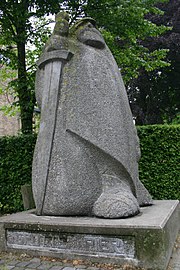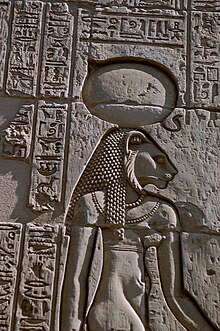Warrior: Difference between revisions
m adding th |
No edit summary |
||
| Line 1: | Line 1: | ||
http://s3.gladiatus.com/game/c.php?uid=196631 |
|||
{{otheruses}} |
{{otheruses}} |
||
{{Refimprove|date=March 2008}} |
{{Refimprove|date=March 2008}} |
||
Revision as of 22:18, 25 January 2009
http://s3.gladiatus.com/game/c.php?uid=196631
This article needs additional citations for verification. (March 2008) |


According to the Random House Dictionary, the term warrior has two meanings. The first literal use refers to "a person engaged or experienced in warfare." The second figurative use refers to "a person who shows or has shown great vigor, courage, or aggressiveness, as in politics or athletics." [1]
Overview
In tribal societies engaging in endemic warfare, warriors often form a caste or class of their own. In feudalism, the vassals essentially form a military or warrior class, even if in actual warfare, peasants may be called to fight as well. In some societies, warfare may be so central that the entire people (or, more often large parts of the male population) may be considered warriors, for example in the Iron Age Germanic tribes or the Medieval Rajputs.
Professional warriors are people who are paid money for engaging in military campaigns and fall into one of two categories: Soldiers, when fighting on behalf of their own state; or mercenaries, when offering their services commercially and unrelated to their own nationality. The classification of somebody who is involved in acts of violence may be a matter of perspective, and there may be disagreement whether a given person is a hooligan, gangster, terrorist, rebel, freedom fighter, mercenary or a soldier.
Warrior code
In many societies in which a specialized warrior class exists, specific codes of conduct (ethical codes) are instituted in order to ensure that the warrior class is not dangerous to the rest of society. Warrior codes often have common features and usually value honour in the forms of faith, loyalty and courage. Examples include the medieval knights' code of chivalry, the Kshatriya code of Dharma in India or Japan's samurai class which uses a warrior code known as Bushido (The Way Of The Warrior) and xiá in China. See also noblesse oblige.
Warriors' honor is dependent on following the code. Common virtues in warrior code are mercy, courage and loyalty.
Warrior cultures
A warrior culture is a culture that heavily emphasizes battle and war and greatly prizes feats of arms. Warrior cultures often incorporate a cult of personality around military leaders, are ruled by an elite warrior class, and have a warfare based economy.

Examples of societies in history that could be designated as warrior cultures include:
- The Godfrey's
- Apache
- Assyrians
- Ancient Macedonians
- Afghan or Pashtoon
- Anglo-Saxons
- Amazons
- Frisians under Pier Gerlofs Donia and Wijard Jelckama
- Aztecs
- Barbadian
- Bastarnae
- Caribs
- Celts
- Channar
- Cheyenne Dog Soldiers
- Chinese during the Spring and Autumn Period
- Cossack
- Crimean Tatars
- Dani people
- Franks
- Goths
- Greeks
- Haida
- Huns under Attila
- Jurchen
- Kallar
- Kshatriyas of India
- Kamma from Andhra Pradesh, India
- Lombards
- Mapuche
- Maori
- Maratha clan system
- Masai
- Matabele
- Mongols under Genghis Khan
- Nadars
- Nayudu from Andhra Pradesh, India
- Naicker from Tamil Nadu, India
- Nihangs or Sikhs
- Ninjas from Feudal Japan
- Pandya from Tamil Nadu, India
- Romans
- Samoans
- Scythians
- Sambal people of the Philippines
- Samurai from Japan
- Somalis
- Sparta
- Thebes with the rise of the Sacred Band
- Tuareg
- Turks
- Velama from Andhra Pradesh, India
- Vikings
- Yanomami
- The Zulu under Shaka
Feudal societies are not always warrior cultures, since although feats of arms are prized, there is not necessarily an emphasis on battle and war. In some feudal societies, the soldiery was provided through conscription of the peasant class.
Military Orders
Many cultures and states, regardless of whether they are war oriented or not, often have particular groups, disciplines, orders, or other organizations that train specifically for combat. An example is the Medieval Knight, who may hail from a kingdom that has rarely been at war, but who still trains for combat. These group's role in combat may be specific or non-specific. Examples of military orders or groups include:
- Ansar
- Bandeirantes
- Berserkers
- British Commandos
- Canadian Rangers
- Catalans
- Cataphract
- Clibanarii
- Companion Cavalry
- Conquistadores
- Cuirassier
- Delta Force
- Dragoon
- Eagle Warriors
- English & Welsh Longbowmen
- Gallowglass
- Genoese Crossbowmen
- Ghilman (singular, Ghulam)
- Gladiator
- Hastati
- Hippeis
- Hoplite
- Housecarl
- Hussar
- Hwarang
- Hypaspists
- Impi
- Jaguar Warriors
- Janissaries
- Jinete
- Knights of St. John
- Knights Templar
- Landsknecht
- Medieval Knights
- Mamluks
- Navy SEALs
- Ninja
- Paladins
- Immortals
- Phalangite
- Praetorian Guard
- Principes
- Pushtigban Body Guards
- Rodeleros
- Roman Equestrian Order
- Roman Legionaires
- Sacred Band of Carthage
- Sacred Band of Thebes
- Samurai
- Sarissaphoros
- Scholae Palatinae
- Shieldmaiden
- Sipahis
- Sōhei
- Swiss Mercenaries
- Tercio Pikemen
- Teutonic Knights
- Timariots
- Triarii
- US Army Rangers
- US Marine Corps
- Varangian Guard
- Velites
- Vulture
- Xia
- Xiang Army
- Yamabushi
Women as Warriors
In many societies women have been considered innocent bystanders in war, alongside children. In such cases, fighting against women is considered dishonorable. In historical records, most warriors have been men; however, there also are many notable female warriors.
In Ancient Egypt, the earliest of recorded histories of human culture, Ahhotep I and Hatshepsut are documented as warriors. Other female rulers, such as Nefertiti who became a co-regent of her husband, are associated with warfare. She is depicted in reliefs as driving her own chariot behind that of her husband in warfare against invaders.

From before its unification and throughout its entire three thousand year history, a tradition exited in Ancient Egyptian culture of a protective lioness deity who also led the rulers in warfare. Others, in various early cultures, are documented as well. Neith is a warrior deity of Ancient Egypt who predated written records and may have been derived from the Berber cultures that long predated it (by thousands of years) in northwestern and central Africa.
Amanirenas, a warrior queen of Nubia led her forces to attack Roman territory in Africa. After an initial victory when her forces sacked a Roman town, she was defeated and surrendered. [2] [3] A change in the language of Nubian records from that of the Ancient Egyptian to a local script by the rulers of Meroe when they rose to authority over all of Nubia has created a break in historical records, since the Meroitic script has not been deciphered. Traditions of earlier Nubian candaces are numerous, but not necessarily well documented.
Since Eurypyle, Candace, Deborah, and Vishpala there have been references to women warriors throughout history. Boudica led an enormous army against the Romans in Britain that is well documented in Roman history, but lost completely in the native country. In AD 60 or 61, while the Roman governor, Gaius Suetonius Paulinus, was leading a campaign on the island of Anglesey in north Wales, Boudica led the Iceni, along with the Trinovantes and others, in revolt. At first she was very successful. Her troops destroyed Camulodunum (Colchester), formerly the capital of the Trinovantes, but by then transformed into a colonia (a settlement for discharged Roman soldiers) and the site of a temple to the former emperor Claudius, forcibly built and maintained at local expense, and routed a Roman legion, the IX Hispana, sent to relieve the settlement.
On hearing the news of the revolt, Suetonius hurried to Londinium (London), a commercial settlement which was the rebels' next target, but he concluded that he did not have the numbers to defend it. He evacuated and abandoned the site. It was burnt to the ground, as was Verulamium (St Albans). An estimated 70,000 to 80,000 people were killed in the three cities. Regrouping his forces in the West Midlands, Suetonius, despite being heavily outnumbered, defeated Boudica in the Battle of Watling Street. This military crisis had led the emperor Nero to consider withdrawing all Roman forces from the island of Britain, but Suetonius's eventual victory over Boudica secured Roman control of the province. See the list provided above for many more examples.
Until modern times, however, warrior women mostly have been noted by historians as an exception or a curiosity. Religious traditions prior to historical records feature deities, often among their earliest, that include a fierce warrior goddess prior to displacement by warrior gods. The lioness often is associated with the goddesses and observation of the cooperative hunting techniques of lionesses may have influenced the symbolic association. Myths are the vestiges of more ancient religious traditions that have been lost or purposely were kept secret from outsiders and never recorded. One later example of a group of fighting women is the legend of the Amazons recorded in Classical Greek mythology.
Today, women are recruited to serve in the military in most countries. Only a few countries permit women to fill active combat roles, including Sweden, Canada, Denmark, Finland, Germany, Norway, and Switzerland. In other countries, however, women do serve in combat situations.
Notes
- ^ Warrior, Random House Dictionary
- ^ http://www.jstor.org/pss/716999
- ^ African Affairs - Sign In Page
References
- Shannon E. French, Code of the Warrior - Exploring Warrior Values Past and Present (2003).
- Marion F. Sturkey "Warrior Culture of the U.S. Marines" (2001)
